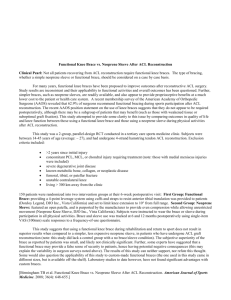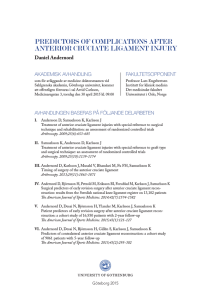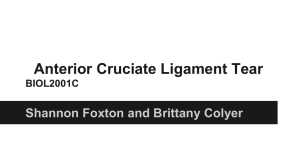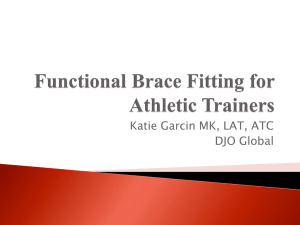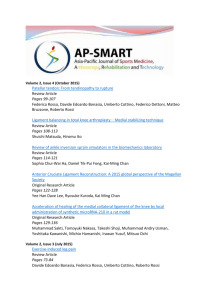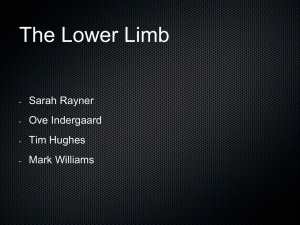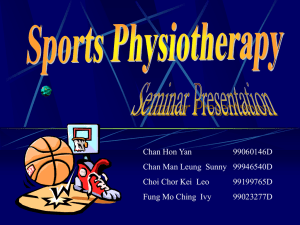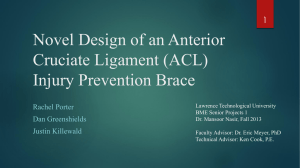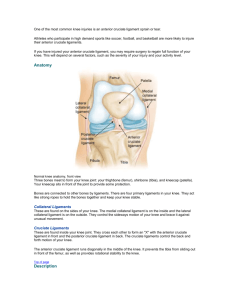Post-operative Bracing for ACL Reconstruction
advertisement
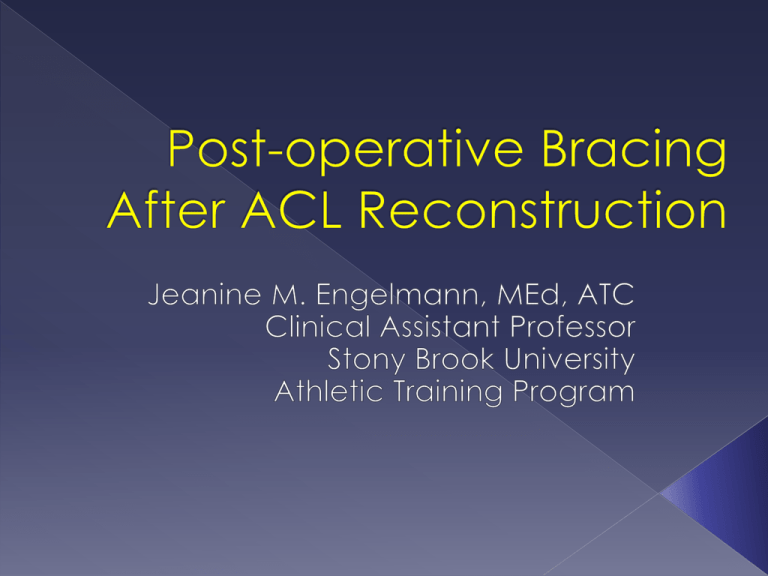
Worn in the early postoperative period (0-6 weeks).1 Lightweight metal hinge bars with multiple padded velcro straps to secure brace to patient’s thigh and lower leg.2 Intended to limit range of motion by locking the brace at a specific ROM point, or within certain ROM limits through an adjustable dial at the hinges.1 Designed to limit extension/flexion motion and varus and valgus stresses at the knee.1 a b c Postoperative bracing has been shown to have some benefits including decreased swelling, hemarthrosis, and pain compared to rehabilitation without a brace.3,4 › Knee immobilizer or post-op. brace Proponents believe these braces help patients achieve knee extension, decrease pain, and protect the reconstructed knee from injury and excessive graft strain.1 Immediate postoperative bracing allows early weight bearing while protecting the knee from buckling due to severe quadriceps weakness and inhibition after surgery.3 Once the patient obtains good quadriceps control with ability to perform a straight leg raise without an extension lag, use of the postoperative brace can be discontinued.4 Rehabilitative bracing has not been shown to have any effect on long-term outcomes. › Once adequate quadriceps strength for ambulation has returned, continued postoperative bracing is unnecessary.3 › Clinical outcomes such as range of motion, laxity, and function do not appear to be affected by the use of rehabilitative braces.4 Wright et al.5 › Review of level 1 and 2 studies identified 54 appropriate randomized controlled trials of ACL rehabilitation, 11 included use of rehabilitative postop. bracing. › No study demonstrated a potentially worse outcome when bracing was not used immediately postoperatively. No increased rate of injury, pain, decreased ROM, or increased laxity compared to braced patients › Only one study6 demonstrated a potentially clinically significant finding. Improved knee extension following one week of locked extension bracing postoperatively Worn to potentially decrease the risk of reinjury when the patient returns to sport after surgery.1 Wide variety of designs available as custom or off-the-shelf derotational braces for post-surgical ACL patients. Consist of a rigid frame with hinge-poststraps and Velcro straps.2 Intended to limit anterior tibial translation and rotation at the knee joint.7 d e Functional brace use after ACL reconstruction may:3,7 › improve proprioception. › improve confidence in knee during return to play. Use of functional braces after ACL reconstruction is controversial.1,3,7,8 Majority of studies have failed to show any long-term differences in pain1, ROM1,3, strength3, functional tests3,7, joint stability7,8, graft stability1, re-injury rates1,8, kinesthetic awareness8, or knee scores3 compared to patients who did not use a functional brace during rehabilitation and return to play after ACL reconstruction. Rate of use by orthopedic surgeons9 › Do you recommend functional braces for full return to activity? Yes No Sometimes NORTH AMERICA (199) 17.6% (35) 37.2% (74) 45.2% (90) EUROPE (35) 2.9% (1) 31.4% (11) 65.7% (23) SOUTH AMERICA (85) 1.2% (1) 88.2% (75) 10.6% (9) Reports of recommended use of functional braces by US orthopedic surgeons have ranged from 58%- 63%.9,10,11 Studies to determine the effect of functional braces on re-injury rates after ACL rsurgery have many limitations. › Lack of power:3 Re-injury rates overall after ACL reconstruction are low, so the number of patients needed to power a study on re-injury rate is very high. › Wright1 performed a review of Level I evidence to determine if there was appropriate evidence to support the use of functional braces after ACL reconstruction. 12 randomized controlled trials found between years 1966-2005 All 12 had potential biases- 10 selection, 2 exclusion Sterett et al.12 investigated the effect of functional bracing on subsequent knee injury in ACL reconstructed skiers. Study performed over 2 years at large ski resort. › All subjects were employees 820 subjects with ACL reconstruction performed ≥2 yrs. prior to data collection were given the option of using a functional brace during skiing activity, or going bracefree. › 257 braced, 563 non-braced Sterett et al,12 continued 61 new injuries recorded › 51 non-braced (8.9 injuries/100 knees/season) 25 required surgery › 10 braced (4.0 injuries/100 knees/season) 3 required surgery › Non-braced group was 2.74 times more likely to be injured than braced group. Use of a brace did not lower injury rate to that of a skier with no previous ACL injury (2.1%). 1. Wright RW & Fester GB. Bracing after ACL reconstruction: A systematic review. Clin Orthop Relat Res. 2007;455:162-8. doi: 10.1097/BLO.0b013e31802c9360 2. Beam JW. Orthopedic Taping, Wrapping, Bracing & Padding. 2nd ed. Philadelphia, PA: F.A. Davis Company, 2012. 3. Albright JC & Crepeau AE. Functional bracing and return to play after anterior cruciate ligament reconstruction in the pediatric and adolescent patient. Clin Sports Med. 2011;30:8115.doi:10.1016/j.csm.2011.06.001 4. Manske RC, Prohanska D, & Lucas B. Recent advances following anterior cruciate ligament reconstruction: Rehabilitation perspectives. Curr Rev Musculoskelet Med. 2012;5(1):59-71. 5. Wright RW, et al. A systematic review of anterior cruciate ligament reconstruction rehabilitation: Part I: Continuous passive motion, early weight bearing, postoperative bracing, and home-based rehabilitation. J Knee Surg. 2008;21:217-24. 6. Melegati G, et al. The role of the rehabilitation brace in restoring knee extension after anterior cruciate ligament reconstruction: A prospective controlled study. Knee Surg Sports Traumatol Arthrosc. 2003;11:322-326. 7. Birmingham TB, et al. A randomized control trial comparing the effectiveness of functional knee brace and neoprene sleeve use after anterior cruciate ligament reconstruction. AJSM. 2008;36(4):648-655. doi: 10.1177/0363546507311601 8. Pezzullo DJ & Fadale PF. Current controversies in rehabilitation after anterior cruciate ligament reconstruction. Sports Med Arthrosc Rev. 2010;18(1):43-47. 9. Cook C et al. Continental variations in preoperative and postoperative management of patients with anterior cruciate ligament repair. Eur J Phys Rehabil Med. 2008;44(3):253-61. 10. Marx RG et al. Beliefs and attitudes of members of the American Academy of Orthopaedic Surgeons regarding the treatment of anterior cruciate ligament injury. Arthroscopy. 2003;19:762-70. 11. Wentzensen A & Hochstein P. Management of anterior cruciate ligament rupture: Indications, choice of procedure, timing, concomitant and aftercare. Zentralbl Chir. 1998;123:970-80. 12. Sterett WI, Briggs KK, Farley T, Steadman, JR. Effect of functional bracing on knee injury in skiers with anterior cruciate ligament reconstruction. AJSM. 2006;34(10):15815.doi:10.1177/0363546506289883 a. Use of Knee Braces in Comprehensive Knee Rehabilitation & Knee Pain Management. Availableat www.drbraceco.com b. www.biodynamictech.com/po_kneebrace.html c. Capitaldealsonline.com/store/the-bledsoe-rehab-knee-brace-regular-red-w-quicklok-hinge/ d. Rishiraj et al. Functional knee bracing and athletic performance. Journal of Foot and Ankle Research.2011, Available at www.lowerextremity review.com/article/functional-knee-bracing-andathletic-performance e. www.breg.com

